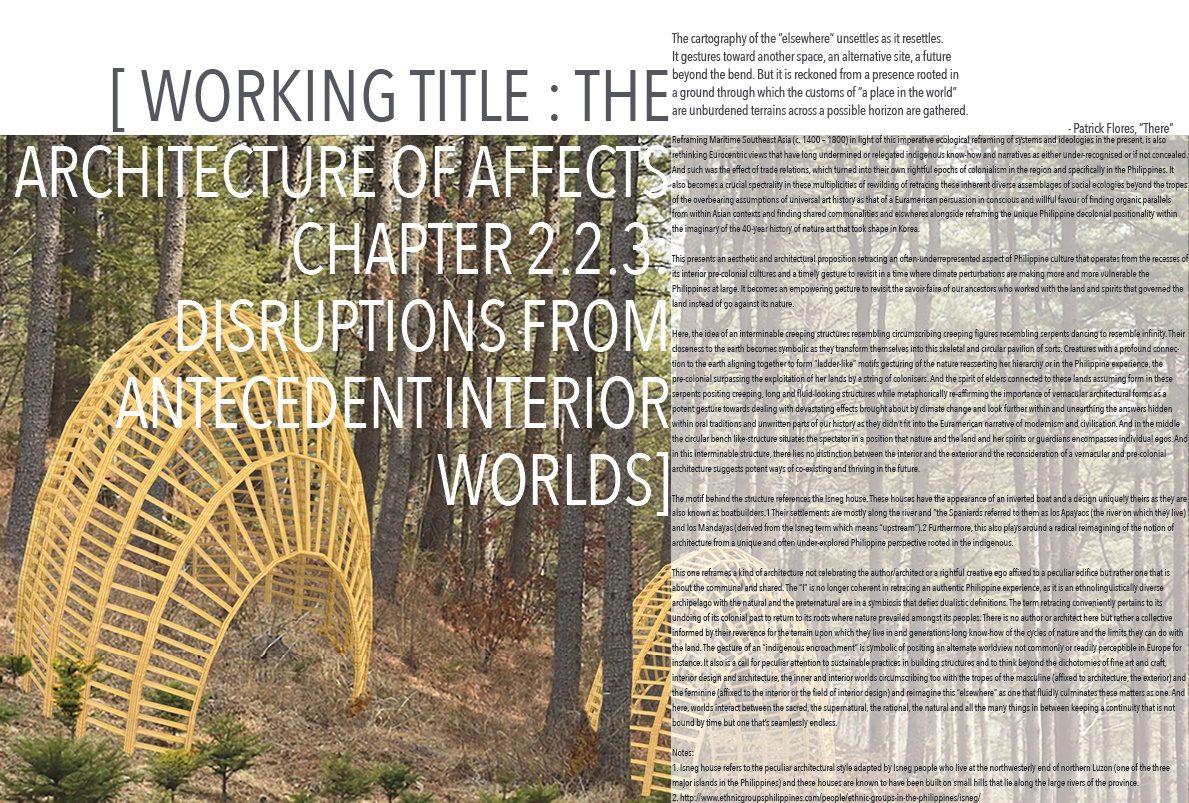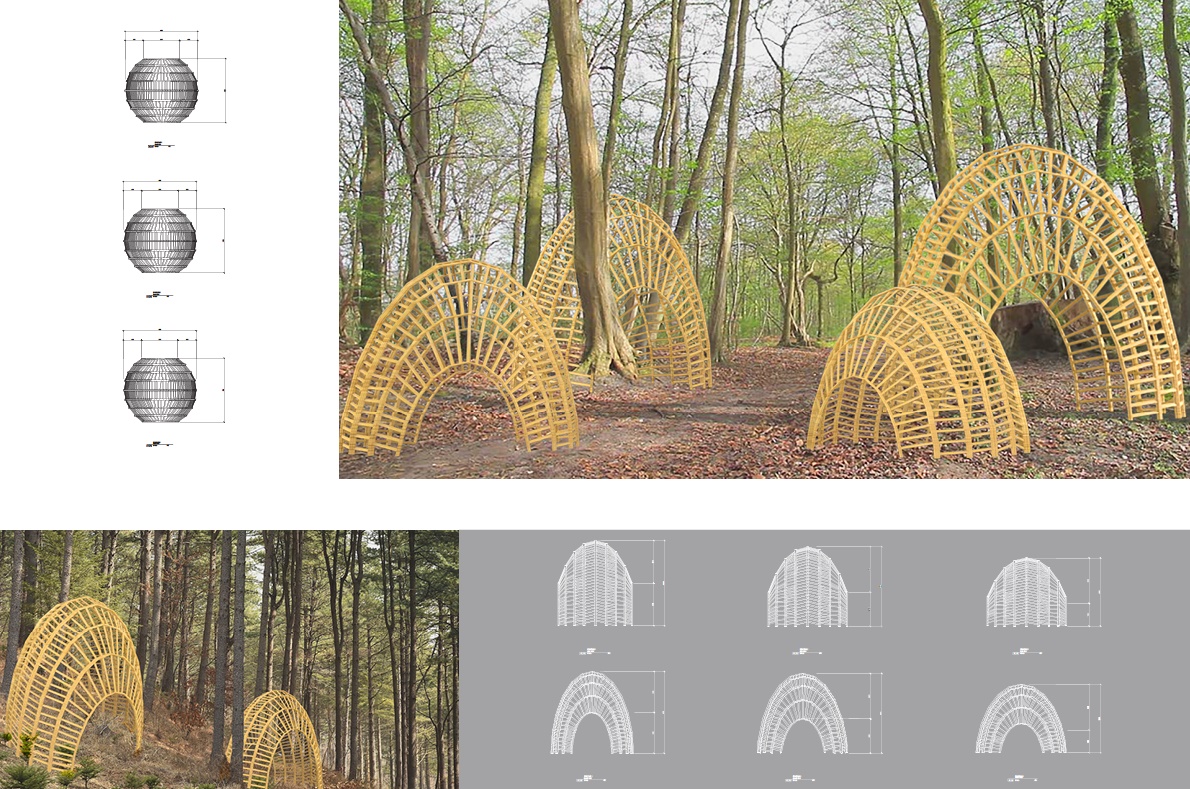[ 2021 ] louta et al._지안 크루즈, 루이 T. 나바로 (필리핀) louta et al._Gian Cruz, Louie T. …
페이지 정보
본문
louta et al._지안 크루즈, 루이 T. 나바로 (필리핀)
louta et al._Gian Cruz, Louie T. Navarro (Philippines)
<감정의 건축 2.2.3 : 선행하는 내부세계로부터의 붕괴 The Architecture of Affects Chapter 2.2.3 : Disruptions from Antecedent Interior Worlds>


“다른 곳”이라는 지도제작법은 다시 정착시키기도 하지만, 근거지를 빼앗기도 한다.
그것은 다른 공간, 대안의 장소, 모퉁이 너머의 세상을 가리킨다. 그러나 이것은 땅에 뿌리를 둔 존재로부터 인정되는 것이다. 그것을 통해 “이 세상에서의 장소”가 가능한 지평에 존재하는 부담 없는 지형이 되는 것이다.
- Patrick Flores, “그곳” [Patrick Flores는 필리핀 미술학 교수]
오늘날 절박한 체제와 이념의 생태학적 재설정의 관점에서 『해양 동남아시아의 재설정 (c. 1400–1800)』을 논하는 것은 토착민들의 지식과 이야기들을 미개한 것으로 깎아내렸던 유럽 중심적 관점을 다시 생각해보는 것이다. 그리고 이것은 유럽 국가들의 동남아 지역, 특히 필리핀에서의 식민지 시절 무역 관계의 영향이었다. 그것은 또한 유럽-미국식의 보편적인 미술사를 뛰어넘어 토착적인 다양한 사회생태를 추적하는 재야생화의 관점이 되었다. 그것은 아시아적 맥락 속 한국에서 형성된 40년 역사의 자연 미술에 대한 상상력 속에서 필리핀의 독특한 탈식민적 위치를 재정립하는 것이다.
이것은 필리핀 문화에서 그동안 경시되었던 식민지 이전의 고유한 문화들 속 미학적, 건축학적인 제안을 하는 것이고, 기후변화가 필리핀 전체를 점점 더 취약하게 만드는 시기에 시의적절한 몸짓으로 제안하는 것이다. 이것은 땅과 함께 일했던, 그리고 자연에 대항하는 대신에 자연을 지배하는 영혼들과 함께했던 우리 조상들의 지혜를 다시 소환하는 것이다.
여기에서, 끝이 없는 기어가는 구조물은 뱀이 춤을 추는 것과 닮았고, 무한성을 닮았다. 그들이 뼈대만 남은 원형의 건축물로 변형되면서 땅에 가까이 있는 것은 상징적이다. 땅과 깊은 연결성을 가진 존재들은 수직적 관계를 재주장하는 자연에 대한 “사다리-같은” 동기들을 형성한다. 필리핀의 역사에서 이는 식민주의자들이 땅을 착취한 것을 뛰어넘어 식민지 이전의 것을 의미한다. 이 땅에 연결된 우리 조상들의 영혼은 땅을 기어가는 듯한, 길고 유연하게 보이는 건축적 형태 속에서 기후변화 때문에 야기된 파괴적인 효과를 치유할 강력한 몸짓으로 자리 잡고 있다. 이런 영혼은 근대화 문명에 대한 유럽-아메리카적인 이야기들에 맞지 않는 필리핀의 구전과 필리핀 역사에서 글로 표현된 부분에서 그 해답을 찾고 있다. 그리고 그 중간에 있는 원형 벤치 같은 구조물은 관람객들이 앉아서 자연과 땅 그리고 땅의 영혼 혹은 수호자들이 각 개인의 자아를 포용하도록 해준다. 그리고 이 무한한 구조물에서 외부와 내부는 구별이 없으며, 토속적인 식민지 이전 시절의 건축에 대한 재고는 미래에 자연과 공존하면서 번성할 여러 가지 방법들을 제시한다.
이 구조물은 이스네그(Isneg) 가옥에서 영감을 얻은 것이다. 이스네그 가옥은 뒤집은 배의 모습을 닮았다. 이스네그인들은 선박 건축으로 유명하다. 이들의 거처는 대체로 강가이고, 스페인인들은 이들을 los Apayaos, los Mandayas라고 불렀는데, 이는 바로 강 이름 아파야오스(Apayaos)에서 딴 것이고, Mandayas는 이스네그어로 강의 상류라는 의미이다. 이는 독특한 필리핀 토착민들의 건축에 대한 관념을 나타낸다.
이 작품은 특정한 구조물의 작가/건축가를 찬양하기 위한 명칭을 사용하지 않고, 공동체적이고 공유하는 개념을 사용한다. “나”라는 표현은 필리핀 고유의 경험을 소환하는 데는 맞지 않는다. 종족적, 언어적으로 다양한 다도해로 구성된 필리핀은 이분법적인 정의를 부정하는 공생관계를 받아들인다.
소환한다는 것은 식민지적 과거를 부정하고, 자연이 사람들을 지배하던 뿌리로 되돌아가는 것이다. 거기에는 작가도 없었고, 건축가도 없었다. 다만 그들이 살아가는 땅, 그리고 자연의 주기에 대한 지식, 인간의 능력의 한계에 대한 지식, 자연에 대한 존경심에 기인한 집단 지성이 있었다. “토착적인 잠식”은 유럽에서 보편적으로 받아들이는 관점이 아닌, 대안적 세계관을 제시하는 것이다. 이것은 건축물을 만드는 데 있어서 지속 가능한 관행, 그리고 미술과 공예, 인테리어 디자인과 건축, 남성적인 것(건축, 외관)과 여성적인 것(인테리어 디자인 등)의 이분법적 관념들을 뛰어넘어, 이런 것들을 하나로 유연하게 통합하는 것으로서 “다른 곳"을 재상상하는 것이다. 그리고 여기에서는 신성한 것, 초물질적인 것, 합리적인 것, 그리고 시간에 구애를 받지 않고 끝없는 어떤 것 사이에 있는 많은 것들이 상호작용한다.
참고:
1. 이스네그(Isneg) 가옥은 루손섬(필리핀의 3개 주요 섬들 중 하나) 북부에 사는 이스네그족 사람들의 독특한 건축 양식이다. 이 가옥은 큰 강가에 있는 작은 언덕 위에 세워졌다.
2. http://www.ethnicgroupsphilippines.com/people/ethnic-groups-in-the-philippines/isneg/
The cartography of the “elsewhere” unsettles as it resettles.
It gestures toward another space, an alternative site, a future beyond the bend. But it is reckoned from a presence rooted in a ground through which the customs of “a place in the world” are unburdened terrains across a possible horizon are gathered.
- Patrick Flores, “There”
Reframing Maritime Southeast Asia(c. 1400–1800) in light of this imperative ecological reframing of systems and ideologies in the present, is also rethinking Eurocentric views that have long undermined or relegated indigenous know-how and narratives as either under-recognised or if not concealed. And such was the effect of trade relations, which turned into their own rightful epochs of colonialism in the region and specifically in the Philippines. It also becomes a crucial spectrality in these multiplicities of rewilding of retracing these inherent diverse assemblages of social ecologies beyond the tropes of the overbearing assumptions of universal art history as that of a Euramerican persuasion in conscious and willful favour of finding organic parallels from within Asian contexts and finding shared commonalities and elswheres alongside reframing the unique Philippine decolonial positionality within the imaginary of the 40-year history of nature art that took shape in Korea.
This presents an aesthetic and architectural proposition retracing an often-underrepresented aspect of Philippine culture that operates from the recesses of its interior pre-colonial cultures and a timely gesture to revisit in a time where climate perturbations are making more and more vulnerable the Philippines at large. It becomes an empowering gesture to revisit the savoir-faire of our ancestors who worked with the land and spirits that governed the land instead of go against its nature.
Here, the idea of an interminable creeping structures resembling circumscribing creeping figures resembling serpents dancing to resemble infinity. Their closeness to the earth becomes symbolic as they transform themselves into this skeletal and circular pavilion of sorts. Creatures with a profound connection to the earth aligning together to form “ladder-like” motifs gesturing of the nature reasserting her hierarchy or in the Philippine experience, the pre-colonial surpassing the exploitation of her lands by a string of colonisers. And the spirit of elders connected to these lands assuming form in these serpents positing creeping, long and fluid-looking structures while metaphorically re-affirming the importance of vernacular architectural forms as a potent gesture towards dealing with devastating effects brought about by climate change and look further within and unearthing the answers hidden within oral traditions and unwritten parts of our history as they didn’t fit into the Euramerican narrative of modernism and civilisation. And in the middle the circular bench like-structure situates the spectator in a position that nature and the land and her spirits or guardians encompasses individual egos. And in this interminable structure, there lies no distinction between the interior and the exterior and the reconsideration of a vernacular and pre-colonial architecture suggests potent ways of co-existing and thriving in the future.
The motif behind the structure references the Isneg house. These houses have the appearance of an inverted boat and a design uniquely theirs as they are also known as boatbuilders. 1 Their settlements are mostly along the river and “the Spaniards referred to them as los Apayaos (the river on which they live) and los Mandayas(derived from the Isneg term which means “upstream”). 2 Furthermore, this also plays around a radical reimagining of the notion of architecture from a unique and often under-explored Philippine perspective rooted in the indigenous.
This one reframes a kind of architecture not celebrating the author/architect or a rightful creative ego affixed to a peculiar edifice but rather one that is about the communal and shared. The “I” is no longer coherent in retracing an authentic Philippine experience, as it is an ethnolinguistically diverse archipelago with the natural and the preternatural are in a symbiosis that defies dualistic definitions. The term retracing conveniently pertains to its undoing of its colonial past to return to its roots where nature prevailed amongst its people. There is no author or architect here but rather a collective informed by their reverence for the terrain upon which they live in and generations-long know-how of the cycles of nature and the limits they can do with the land. The gesture of an “indigenous encroachment” is symbolic of positing an alternate worldview not commonly or readily perceptible in Europe for instance. It also is a call for peculiar attention to sustainable practices in building structures and to think beyond the dichotomies of fine art and craft, interior design and architecture, the inner and interior worlds circumscribing too with the tropes of the masculine (affixed to architecture, the exterior) and the feminine(affixed to the interior or the field of interior design) and reimagine this “elsewhere” as one that fluidly culminates these matters as one. And here, worlds interact between the sacred, the supernatural, the rational, the natural and all the many things in between keeping a continuity that is not bound by time but one that’s seamlessly endless.
Notes:
1. Isneg house refers to the peculiar architectural style adapted by Isneg people who live at the northwesterly end of northern Luzon (one of the three major islands in the Philippines) and these houses are known to have been built on small hills that lie along the large rivers of the province.
2. http://www.ethnicgroupsphilippines.com/people/ethnic-groups-in-the-philippines/isneg/
- 이전글루디라 유다 (인도네시아) Ludira Yudha (Indonesia) 21.08.30
- 다음글리빙스턴 아모아코 (가나) Livingstone Amoako (Ghana) 21.08.30
댓글목록
등록된 댓글이 없습니다.


